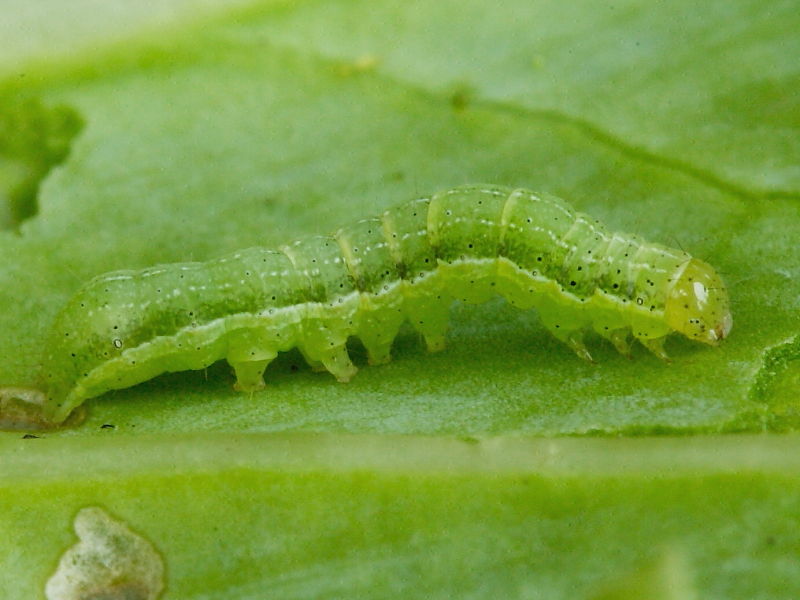In this Issue:
- Thrips: seen on a variety of vegetable crops throughout Utah
- Imported Cabbageworm: out and about laying eggs
- Powdery Mildew: seen on cucurbits in high tunnels
- Squash Bugs: start monitoring early on
Thrips (Onion Thrips: Thrips tobaci, Western Flower Thrips: Frankliniella occidentalis)
Overview
Thrips have been seen throughout Utah on a variety of vegetable host crops including artichoke, beans, cabbage, cauliflower, corn, cucurbits, eggplants, garlic, leafy greens, onions, peppers, peas, and tomatoes. They are also found on ornamental grasses, flowers, and weeds. Two common thrips species found in Utah include the Onion Thrip (Thrips tabaci) and the Western Flower Thrip (Frankliniella occidentalis). Both are less than 1.5 mm long and are best identified with a hand lens or microscope. Adults have clear yellow-brown bodies with fringed wings. The larvae are yellow. Up to 8 generations can occur within a year and the adults will overwinter in plant debris or protected areas.
Damage
Thrips will feed by piercing and sucking host plants which leave notable speck marks. Thrips have the potential to vector various tospoviruses including tomato spotted wilt virus on solanaceae crops and iris yellow spot virus on allium crops.
Management
Begin monitoring for adults in the spring, look for the bleached specks on foliage and dark fecal spots. Onion thrips are commonly found in the neck of the onion. Thrips thrive in hot arid conditions but can decrease in rain.
– Keep the area free of weeds
– Use overhead irrigation to wash thrips off the host plants
– Remove all plant debris at the end of the season to prevent overwintering
– Click here to view synthetic and organic insecticide options for home use
– Click here to view synthetic and organic insecticide options for commercial use
Additional Resources
Onion Thrips (USU Fact Sheet)
Western Flower Thrips (USU Fact Sheet)
Thrips (University of California IPM Program)
Onion Thrips (Penn State University Extension)
Imported Cabbageworm (Pieris rapae)
Overview
Imported Cabbageworms are the larvae stage of the Cabbage White Butterfly. Host plants include brassicas such as broccoli, Brussel sprouts, cabbage, and related weeds. The larvae grow from 4-30 mm long throughout their life. They are green and appear fuzzy. The adults are white-yellow butterflies and notable fluttering above the crops throughout the day. The eggs are small, yellow, and rocket-shaped. They are found on the leaves.
Damage
The larvae have chewing mouthparts which can cause serious defoliation in the foliage leaving large ragged holes.
Management
Cabbageworms are a concern throughout the entire growing season. Monitor for adult butterflies throughout the day. Look for the worms on the underside of the leaves throughout your crops. Feeding damage and frass is a common sign of infestations.
– Implement row covers to prevent butterflies from laying their eggs.
– Remove plant debris at the end of the season to disrupt overwintering pupae.
– Manually remove insect larvae.
– Click here to view synthetic and organic insecticide options for home use
– Click here to view synthetic and organic insecticide options for commercial use
Additional Resources
Caterpillar Pests of Brassica Vegetables (USU Fact Sheet)
Imported Cabbageworm (Florida Extension)
Powdery Mildew on Cucurbits (Podosphaera xanthii or Erysiphe cichoracearum)
Overview
Powdery Mildew on cucurbit crops (squashes, melons, and pumpkins) is very common throughout Utah. Infections occur in high temperatures (75-85 degrees F) and minimal rainfall. Because of the moisture this year, we’re not seeing infections early on. However, infections have been reported in high tunnel structures.
Powdery Mildew is a fungal growth that occurs on the leaves, stems, and petioles. They start as a few white fungal spots that eventually spread covering the entire plant which causes it to wilt and sunscald which reduces marketable yield.
Management
Begin scouting your crops now! Early detection is important, look at the older leaves along with the undersides.
– Remove old plant debris at the end of the season.
– Provide plants adequate spacing to minimize spread.
– Remove early infected leaves when identified.
– Click here to view synthetic and organic fungicide options for home use
– Click here to view synthetic and organic fungicide options for commercial use
Additional Resources
Managing Cucurbit Powdery Mildew Organically (Cornell University Extension)
Powdery Mildew of Cucurbits (Minnesota Extension)
Squash Bugs (Bactericera cockerelli)
Overview
Squash bugs are typically a problem for commercial and home growers ever season. Take action by monitoring and controlling this pest now early in the season. Squash bugs target winter squash, summer squash, and melons. Adults bugs are flat with brown/gray with or orange/brown bands along the margins of their abdomen. Nymphs are bright green but turn gray/brown as they develop through 5 growth stages. The eggs are a shiny red bronze color found on the underside of foliage.
Damage
Both adults and nymphs have piercing-sucking mouthparts which can cause yellow flecks on the foliage. Eventually, the foliage will wilt and cause the plant to die off. Feeding can also occur on the fruit which can cause wounding and lead to fruit rot.
Management
Squash bugs are mostly a concern once the plants starting developing runners and throughout harvest. Monitor in the spring for adults that overwintered in nearby protected sites such as buildings, under plant debris, or compost piles. Look for and remove eggs clusters underneath the foliage.
– Rotate crops annually with non-cucurbit crops.
– Remove plant debris at the end of the season to prevent overwintering.
– Use wooden boards and place them between susceptible plants, then in the mornings lift them and destroy aggregated adults and eggs.
– Click here to view synthetic and organic insecticide options for home use
– Click here to view synthetic and organic insecticide options for commercial use
Additional Resources
How to Control Squash Bugs With Water (USU Extension)
Squash Bug (USU Fact Sheet)
Squash Bug (Maryland Extension)




